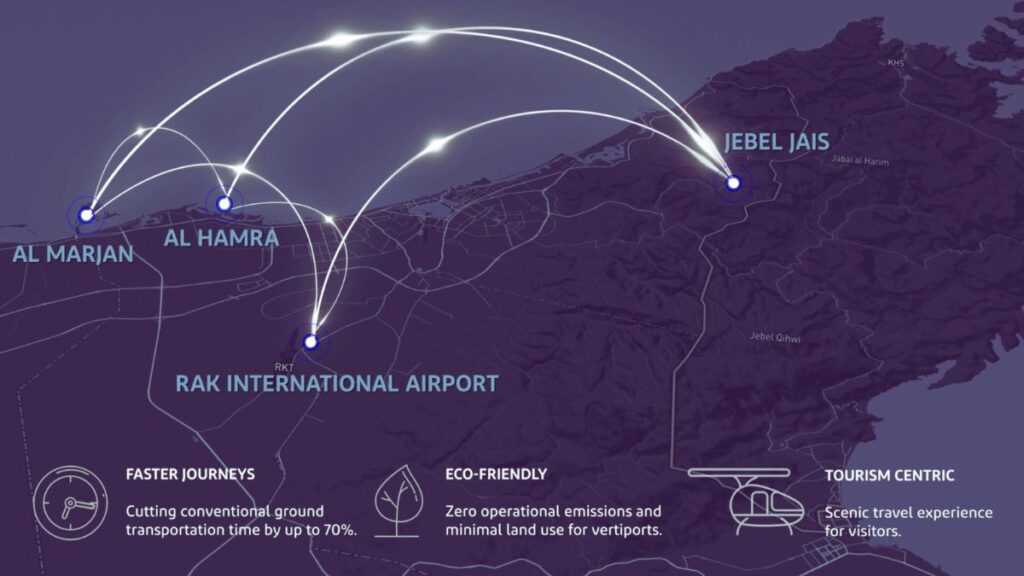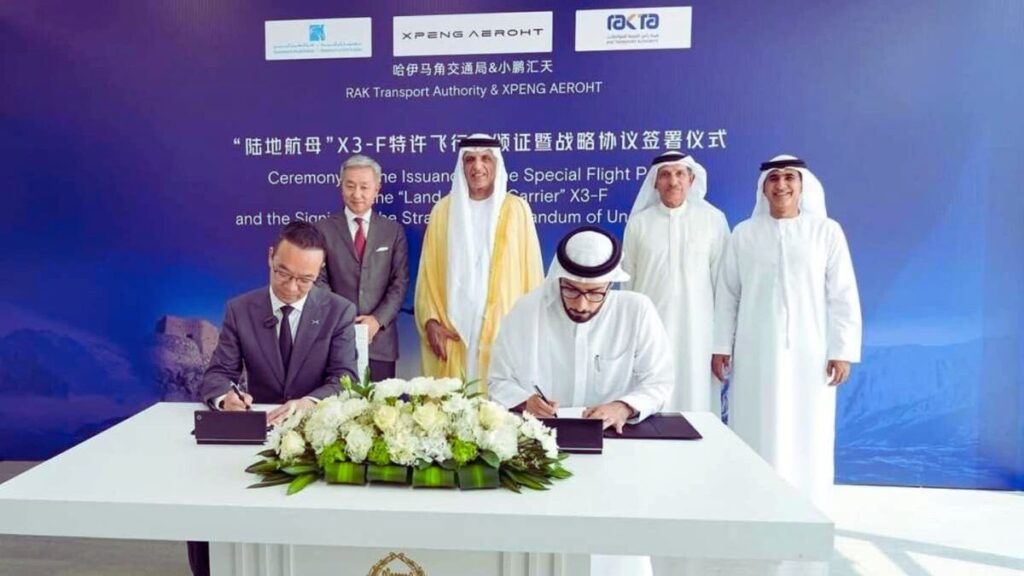Ras Al Khaimah just did the most RAK thing ever: made sci-fi practical. At Al Jazirah Aviation Club, an electric flying car lifted off as Sheikh Saud watched—backed by a special flight permit and fresh MoUs. Here’s what that means for your weekend trips, airport runs, and life in the mountains.
Imagine sipping your morning karak by the beach in Ras Al Khaimah when—whoosh!—a futuristic electric flying car quietly lifts off nearby. Nope, this isn’t a sci-fi daydream. It’s history in motion: RAK’s first ever flying-car test flight, making the emirate the latest to join the UAE’s sky-mobility race after Dubai and Abu Dhabi.
Backed by a special flight permit, XPENG AEROHT’s modular flying car took flight in front of Sheikh Saud bin Saqr Al Qasimi. On the same day, RAKTA ↔ XPENG signed an MoU—stacked on RAK’s earlier moves with Skyports and VPorts to build vertiports from Al Marjan to Jebel Jais and connect the dots at RAK Airport.
What that actually means?
- Weekend plans: Al Marjan → Jebel Jais in <20 mins (projected) instead of 70 by car.
- Tourism glow-up: zero-emission air taxi UAE hops between coast, city, and mountains.
- Real utility: faster emergency response, cleaner commutes, and a serious boost to sustainable transportation UAE.
And honestly? It’s not just a “cool tech demo.” This moment might just rewrite how we think about commutes, road trips, tourism, and even emergency rescues across the Emirates.
WOW-Emirates Expert Tip 💡
Bookmark this page. We’ll keep a live timeline + news ticker so you’ll know the exact moment test flights become bookable rides.

✈️ Will Flying Cars Change My Trip in RAK?
| Route | Today (Car) | Future by eVTOL | Why it matters |
|---|---|---|---|
| Al Marjan → Jebel Jais | ~70 min | < 20 min | More time soaking up mountain views, less time stuck on Sheikh Mohammed Bin Salem Rd. |
| Al Hamra → Al Jazirah Aviation Club | ~20–25 min | 6–8 min | Quick scenic hops for visitors; easier access for aviation activities. |
| RAK City → RAK International Airport | ~25–35 min | 8–10 min | Smoother transfers for premium travelers and tourists connecting to flights. |
WOW-Emirates Expert Tip 💡 Think of this like swapping your 1-hour highway drive for a 15-minute sky taxi. Sure, it’ll start as a premium service—but once vertiports multiply, your weekend brunch at Jebel Jais could literally begin in the clouds.
A Historic First: Flying Cars in Ras Al Khaimah
On a sunny September morning at Al Jazirah Aviation Club, the crowd held its breath as XPENG AEROHT’s “Land Aircraft Carrier” (yep, that’s really its name) fired up. Sheikh Saud bin Saqr Al Qasimi, Ruler of Ras Al Khaimah, watched as the sleek eVTOL (electric vertical take-off and landing aircraft) lifted into the skies.
Cue goosebumps. Cue “wow, the future is here” Instagram captions. Cue aviation geeks trying very hard not to faint.
“In Ras Al Khaimah, we look to the future with ambition, turning unconventional ideas into tangible achievements that build a modern, sustainable urban environment.”
— Sheikh Saud bin Saqr Al Qasimi
That’s not a vision statement—it’s a mic drop.

The Big Deal: XPENG × RAKTA
Now, how did this futuristic toy land in RAK’s backyard? Answer: partnerships.
During the event, the Ras Al Khaimah Transport Authority (RAKTA) signed an MoU with XPENG AEROHT. Translation? This isn’t just a test flight; it’s the start of a full-on collaboration to explore real applications:
- Government transport – zip ministers across the city without the traffic.
- Tourism experiences – imagine a 10-minute air taxi ride from Al Hamra to Jebel Jais.
- Emergency rescue – getting medical help to the mountains fast.
💡 WOW-Emirates Expert Tip: Think beyond “flying car joyrides.” RAK’s natural landscapes (mountains, mangroves, desert) make it the perfect playground for aerial tourism. Expect future travel brochures to include “sunset flight over Jebel Jais” as casually as dune bashing or dhow cruising.
Behind the Scenes: Building the Infrastructure
Flying cars don’t just need a landing strip—they need vertiports. And Ras Al Khaimah is not winging it (pun intended).
Here’s how the emirate has been quietly gearing up for this very moment:
Ras Al Khaimah eVTOL Timeline
VPorts MoU to build RAK International Airport’s first vertiport (10,000 m²)
Bootstraps the hard infrastructure for eVTOL in RAK—tourism, medical, cargo.
RAKTA × RAKTDA × Skyports sign eVTOL ecosystem agreement; commercial launch set for 2027
Citywide vertiports to link Al Marjan, Al Hamra & Jebel Jais; Al Marjan → Jebel Jais cut from ~70 min to <20.
RAK Airport announces new 30,000 m² terminal (completion 2028)
Capacity + sustainability upgrades; dovetails with vertiports and next-gen mobility.
XPENG AEROHT conducts the UAE’s first electric flying-car test flight at Al Jazirah Aviation Club
Public proof-of-concept in RAK, witnessed by leadership and dignitaries.
RAKTA ↔ XPENG AEROHT MoU (gov transport, tourism, emergency rescue)
Framework to pilot real services under special permits—demo → deployment.
XPENG modular flying-car deliveries begin (global)
Hardware maturity and supply ramp for early routes, including UAE.
Commercial eVTOL tourism ops launch in RAK via Skyports network
Bookable hops coast ⇄ mountains; premium experiences with zero tailpipe emissions.
RAK Airport’s new terminal goes live
Full ecosystem: aviation + vertiports + routine eVTOL services.
💡WOW-Emirates Expert Tip: If you’re investing in property near Al Marjan or Al Hamra, pat yourself on the back. You’re about to live next to a future vertiport. Talk about “prime location.”
Why eVTOLs Are More Than Just “Cool”
Let’s geek out for a moment. The electric vertical take-off and landing aircraft (say that three times fast) isn’t just about looking futuristic:
- Zero emissions = less guilt, more Instagram stories.
- Low noise = no waking up your neighbors when you lift off for a late-night shawarma run.
- Lower infrastructure cost vs airports. Building vertiports is peanuts compared to traditional runways.
- Speed + flexibility = imagine reaching Jebel Jais in 8 minutes instead of 45.
WOW-Emirates Expert Tip 💡: Think of eVTOLs as the iPhones of aviation. Early adopters will pay a premium, but once the tech scales, your future “Uber” could have wings.

🚁 How Flying Cars Will Work in Ras Al Khaimah
1. Book on your phone
Choose your route in the app—think Al Marjan ⇄ Jebel Jais or Airport ⇄ City. Easy taps, instant confirmation.
2. Arrive at the vertiport
Head to a sleek vertiport integrated with RAKTA’s transport network. Security, quick briefing, zero fuss.
3. Take off—quietly
Board an electric eVTOL. 8–20 minutes of smooth, low-noise flight with jaw-dropping views. Yes, Instagram stories incoming.
4. Land close to the action
Arrive minutes from the summit, the resort, or the airport. Step out and continue your adventure—ground taxi optional.
WOW-Emirates Expert Tip 💡 First vertiports are planned at Al Marjan, Al Hamra, Jebel Jais, and RAK Airport. Book early sunset slots—these will become the new desert safari of Instagram.
Latest Updates You Should Know
- Sept 2025: XPENG “Land Aircraft Carrier” test flight in RAK; MoU with RAKTA signed.
- May 2024: Skyports inks deal to build vertiport network in RAK.
- Mar 2023: VPorts announces first vertiport at RAK Airport.
- Jun 2025: RAK Airport unveils massive new terminal (completion 2028).
- 2027: Joby Aviation to Launch Flying Taxis in Ras Al Khaimah by 2027
Joby Aviation partners with RAKTA for air mobility
Ras Al Khaimah is gearing up to launch flying taxis by 2027, thanks to a new partnership between Joby Aviation, Ras Al Khaimah Transport Authority (RAKTA), and Skyports Infrastructure. The agreement aims to introduce electric vertical takeoff and landing (eVTOL) aircraft for sustainable, high-speed travel across the emirate.
Under the initiative, travelers will soon be able to fly from Dubai to Al Marjan Island in under 15 minutes, cutting down on the usual long drives. Joby Aviation will provide zero-emission aircraft capable of speeds up to 321 km/h, carrying four passengers and a pilot, while Skyports will build the vertiports (futuristic helipads). The plan aligns with RAK’s Comprehensive Mobility Plan 2030, which focuses on smart, sustainable, and integrated transportation.
The first vertiport will be built on Al Marjan Island, near the upcoming Wynn Al Marjan resort, followed by additional sites including Jebel Jais. Joby has already conducted over 40,000 miles of test flights, proving the technology’s reliability.
Joby expects to begin passenger operations in Dubai by 2026 and expand to Ras Al Khaimah in 2027. The project has received the endorsement of H.H. Sheikh Saud bin Saqr Al Qasimi, highlighting RAK’s commitment to futuristic urban mobility.
Ultimately, this initiative positions Ras Al Khaimah as a leader in eco-friendly travel and innovation, turning it into one of the UAE’s most exciting destinations where journeys could soon start — quite literally — in the sky.
Safety & Regulation: Why You Can Trust the Skies
Flying cars sound wild, but they’re not being launched in a free-for-all. Every lift-off in Ras Al Khaimah is wrapped in strict safety layers and regulatory oversight:
- Special flight permits: XPENG’s demo in RAK only happened after securing the UAE’s first manned eVTOL permit. Nothing takes off without paperwork, approvals, and inspections.
- Redundant design: eVTOLs aren’t like single-engine helicopters. They use multiple independent motors and batteries. If one fails, the rest keep you airborne.
- Defined air corridors: Flights won’t zigzag randomly over villas. The General Civil Aviation Authority (GCAA) sets mapped corridors and altitude rules—like invisible highways in the sky.
- Piloted first, autonomous later: Early flights will always have trained pilots at the controls. Automation and autonomy only scale up once there’s mountains of safety data.
- Weather & visibility rules: No storm chasing. Operations pause if conditions don’t meet the strict minimums for safe, stable travel.
WOW-Emirates Expert Tip 💡
Think of this rollout as more “Dubai Metro” than “Back to the Future.” Controlled, phased, and heavily regulated—so you can relax and enjoy the view while the experts do the flying.
⚙️ Specs of the XPENG AEROHT Modular Flying Car
✅ Confirmed
- Capacity (Flight Module): 2 seats (pilot + passenger)
- Ground Carrier: 6×6 van, AWD with rear-wheel steering
- Dimensions (Van): ~5.5m × 2m × 2m
- Range (Van mode): ~1,000 km (CLTC standard)
- Charging (Van): 30–80% in ~18 mins
- Propulsion (Flight): 6 electric VTOL propellers + 2 ducted fans
- Flight Modes: Manual (single-stick), Automatic (one-touch take-off/landing, route planning)
- Materials: Carbon fiber composite for fuselage
- Projected Price: ≤ RMB 2 million (~US$ 280,000)
- Production Target: Mass deliveries in 2026 (~10,000 units/year)
🔜 Still to Come
- Cruising Speed: Not disclosed (expected ~120–200 km/h)
- Flight Range/Duration: Pending official numbers
- Maximum Altitude: Not yet specified
- Payload: Beyond 2 passengers (luggage/cargo capacity TBC)
- Noise Levels: Decibel measurements not published
- Certification: UAE permits granted for test flights, but full type certification pending
WOW-Emirates Expert Tip 💡 Think of this as the **iPhone 1 moment for air taxis**. The basics are solid—quiet lift, clean power, short-hop use cases. The fine print (speed, range, pricing tiers) will be revealed as regulators and engineers stress-test the system before the 2027 tourism rollout in RAK.
UAE in the Global Urban Air Mobility Game
Ras Al Khaimah now stands shoulder-to-shoulder with Dubai and Abu Dhabi in the UAE urban air mobility race. While Dubai is building vertiports with Skyports and Abu Dhabi is creating a full SAVI cluster for eVTOL manufacturing, RAK has carved a niche as the tourism-friendly testbed.
And here’s the kicker: international companies (Joby, Archer, EHang, Regent, XPENG) are all calling UAE their favorite playground because—unlike some global regulators—the UAE actually says: “Yes, let’s fly!”
🚘 Car vs 🚁 Helicopter vs 🚀 Flying Car
| Factor | 🚘 Car | 🚁 Helicopter | 🚀 Flying Car (eVTOL) |
|---|---|---|---|
| Travel Time (Al Marjan → Jebel Jais) | ~70 min | ~25 min | < 20 min |
| Emissions | High (fuel) | High (aviation fuel) | Zero tailpipe (electric) |
| Noise | Low | Very High | Low–Moderate |
| Accessibility | Door-to-door, but traffic | Requires helipad, permits | Vertiports integrated with city |
| Cost | Low (fuel/EV) | Very High (charter fees) | Premium at first, scaling down |
| Experience | Everyday commute | VIP, limited use | Scenic + futuristic + practical |
WOW-Emirates Expert Tip 💡 The flying car isn’t replacing your daily Corolla just yet—but for **tourism hops and premium commutes**, it beats both traffic jams and helicopter headaches.
So, What Does This Mean for You?
- Your next weekend trip to Jebel Jais might not need a car.
- Tourists will soon book “RAK Flying Car Safari” alongside desert safaris.
- Emergency services will save lives faster, with zero emissions.
- And one day, yes, your daily commute might involve more sky than Sheikh Mohammed bin Salem Road.
WOW-Emirates Expert Tip 💡: If you’re still skeptical, remember: people once thought elevators were terrifying. Now you ride them daily without blinking. Flying cars are just the next floor up.
Final Thoughts
Ras Al Khaimah’s electric flying car test flight wasn’t a gimmick—it was a signal. With Sheikh Saud’s leadership, XPENG’s tech, and vertiports already in the pipeline, RAK is officially in the cockpit of the future mobility solutions revolution.
The UAE isn’t just keeping up with the future—it’s racing ahead, one eVTOL at a time.
So buckle up (or should we say “strap in”?). Because the next time you look up over RAK’s coastline, that won’t just be a bird or a plane—it might just be your future taxi.
FAQs: Flying Cars in Ras Al Khaimah
When can tourists actually book an eVTOL ride in RAK?
Target is 2027 for commercial operations via the Skyports vertiport network (subject to regulatory approvals and safety validation). Expect initial routes focused on tourism corridors—coast ⇄ mountains—before broader, everyday mobility opens up. Early phases will likely be pre-booked slots with limited capacity as operators ramp up.
WOW-Emirates Expert Tip 💡 Join the site newsletter—launch routes and promo seats will sell out fast.
How noisy are eVTOLs compared to helicopters?
eVTOLs are engineered for low-noise urban operations. While exact decibel levels vary by model and distance, think “suburban electric hum,” not helicopter thump. Reduced rotor size, distributed propulsion, and optimized flight profiles keep sound lower—especially during takeoff/landing—making them friendlier for residential areas and scenic spots.
WOW-Emirates Expert Tip 💡 Expect dedicated corridors and altitude bands to further minimize community noise.
Is it safe? What’s different from a helicopter?
Safety is built into the architecture: multiple independent motors, redundancy in power and control systems, defined weather minima, and trained pilots in early phases. Regulated corridors and vertiports enable controlled operations. Unlike single-rotor aircraft, distributed electric propulsion reduces single-point failures and allows stable hover/landing even if one motor is offline.
How much will a ticket cost?
Early pricing will be premium—think “airport limo or heli-tour” territory—then trend down as fleets scale and utilization improves. Short hops (8–20 minutes) will likely be priced per seat with dynamic fares around peak tourism windows. Bundles with hotel partners and attraction passes are likely in phase one.
WOW-Emirates Expert Tip 💡 Watch for locals’ off-peak deals once routes stabilize.
Where will the first vertiports be?
Planned nodes align with RAK’s tourism spine: Al Marjan Island, Al Hamra, Jebel Jais, plus airport integration. Expect phased roll-outs—start with a few flagship sites, then expand once demand data and airspace performance look strong.
WOW-Emirates Expert Tip 💡 Properties within a short walk of a vertiport will gain serious convenience value.
What routes make the biggest difference?
Coast ⇄ mountains is the headliner (e.g., Al Marjan → Jebel Jais), shrinking ~70 minutes by car to under 20 minutes by eVTOL (projected). Short connectors like Al Hamra → Al Jazirah Aviation Club and RAK City → Airport unlock fast transfers and scenic hops.
Who’s flying—human pilots or autonomous systems?
Early operations will be piloted under special permits and defined procedures. As reliability data grows, limited autonomy and higher automation will appear—always within regulated frameworks. Full autonomy is a long-term target, not a day-one promise.
How eco-friendly are eVTOLs?
No tailpipe emissions in operation and far lower local noise. The bigger picture includes clean-energy charging, battery lifecycle management, and smart routing to replace longer car trips. For tourism corridors, eVTOLs can shift high-impact road journeys to short, electric aerial hops.
WOW-Emirates Expert Tip 💡 The biggest carbon win comes from replacing long, congested car trips—not tiny hops—so expect routes to optimize real impact.
How do I board—what’s the passenger experience?
Think app-first booking → arrive at a branded vertiport → security & safety briefing → 8–20-minute flight → connect to ground transport or walk to the attraction. Wayfinding, lounges, and luggage policies will be tailored to short, scenic hops rather than long-haul aviation.
What’s the current status in RAK?
Foundational pieces are in place: vertiport agreements (VPorts, Skyports), airport expansion announced, and the successful XPENG test flight with a RAKTA MoU. Next phases include route design, infrastructure build-out, and certification steps toward a 2027 commercial launch target.









